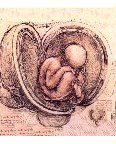Is it safe to attempt pregnancy after uterine rupture?
 |
Published reports over the last 100 years indicate that most women with a previous uterine rupture have a favorable outcome in
subsequent pregnancies. All studies recommend planned cesarean delivery. |
Uterine rupture is a tear through the entire
thickness of the uterine wall. Opening of a surgical scar on the uterus where
the visceral peritoneum stays intact is referred to as an incomplete rupture or
dehiscence. Uterine rupture usually occurs in a woman who has had uterine
surgery such as a cesarean section, myomectomy (removal of fibroids) , or metroplasty (repair of uterine malformation).
Rupture of an unscarred uterus is reported to occur at a rate of less than one
in 8,000 deliveries [1-3]. Uterine rupture occurs in 0.2 and 1.5
percent of pregnancies with one prior low-transverse scar, and in 4 to 9
percent of cases with a previous classic or T-shaped uterine incisions
[4]. An abnormal fetal heart rate, in particular bradycardia, is the most
consistent finding associated with uterine rupture [1,5].
Published reports over the last 100 years indicate that most women with a previous uterine rupture have a favorable outcome in
subsequent pregnancies. The recurrence rate for uterine rupture is reported to be between 4.8 to 19 percent with the highest rates of
recurrence seen in women with a history of a ruptured upper uterine segment (classic
scar) . All studies recommend planned cesarean delivery. Delivery between 37
and 38 weeks is recommended for patients with a history of ruptured lower uterine segment scar.
For patients with a history of a ruptured upper uterine segment scar opinions vary as
to the timing of delivery. Some authors suggest delivery of all patient
with a history of a ruptured upper uterine segment by 35 weeks' while others recommend admission to the hospital one week prior to the age at which labor started in
the previous pregnancy [6,7]
REFERENCES
1. Rageth JC, Juzi C, Grossenbacher H. Delivery after previous cesarean: a risk evaluation. Swiss Working Group of Obstetric and Gynecologic Institutions. Obstet Gynecol 1999;93:332-7.
PUBMED
2. Miller DA, Goodwin TM, Gherman RB, Paul RH. Intrapartum rupture of the unscarred uterus. Obstet Gynecol 1997;89(5 pt 1):671-3.
PUBMED
3. Sweeten KM, Graves WK, Athanassiou A. Spontaneous rupture of the unscarred uterus. Am J Obstet Gynecol 1995;172:1851-6.
PUBMED
4. ACOG practice bulletin. Vaginal birth after previous cesarean delivery. No. 5, July 1999 (replaces practice bulletin no. 2, October 1998). Clinical management guidelines for obstetrician-gynecologists. American College of Obstetricians and Gynecologists. Int J Gynaecol Obstet 1999;66:197-204.PUBMED
5. Cowan RK, Kinch RA, Ellis B, Anderson R. Trial of labor following cesarean delivery. Obstet Gynecol 1994;83:933-6.
PUBMED
6.Sheth SS.Results of treatment of rupture of the uterus by suturing.J Obstet Gynaecol Br Commonw.1968;75(1):55-8. .
PUBMED
7.Lim AC, et al.Pregnancy after uterine rupture: a report of 5 cases and a review of the literature.Obstet Gynecol Surv.2005 ;60(9):613-7.
PUBMED

